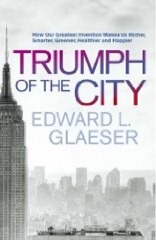One is tempted to say the sub-text to cover of this book should say ‘…And Why Greed Is Good’ but that would be a bit churlish.
It’s probably worth pointing out first that the writer is talking about the triumph of the city as a human construct, not ‘The City’ in a financial context, although for the author the two are clearly, inextricably linked.
Glaesner writes this book from a US, centre-right libertarian viewpoint and makes no bones about his trust in the free market to deliver the optimum urban form for us, although to be fair he is at times even handed and does point out where the public sector and more ‘left-liberal’ policies have a place in city development.
Having said that his appreciation of public sector activity does tend to focus on what that public sector can do for private business [e.g. road infrastructure etc.] rather than the general population that have to live in our urban and suburban areas, and very quickly defaults to the laissez-faire argument: cities are at their most dynamic when the rule book is thrown away and unbridled wealth is allowed to explode, which essentially means inequalities in society are an acceptable urban phenomenon, as that wealth will inevitably ‘trickle down’ to the rest of society. Basically in cities, Greed Is Good.
Now that this Trickle Down theory has now been widely discredited and shown to be a totally defunct idea- it never happened and never will, wealth if anything seeps upwards- makes Glaesner’s approach, despite being written after the Crash of 2007-08, almost quaint and old-fashioned now as the 21st century begins to shape up in an entirely new way from the previous ones. His analysis is growth obsessed; as if [almost] anything goes in the name of growth. Height controls, strict limitations of historic building protection [unless such protection offers an economic premium] and land use zoning amongst many other regulating mechanisms come into Glaesner’s sights as inhibiters to that growth and, as such, should be strictly restricted in their own use [which is a bit of an irony, as most libertarian ideas are]. This isn’t to say he doesn’t make some good points in this book; he is right in stating that human society operates better in an urban environment than a rural one, which inevitably equates to grinding poverty for the masses under the yoke of an elite, but his obsession with growth driven purely by an entrepreneurial and intellectual elite runs the risk of merely transferring that feudal rural society of inequality into the city- as is being seen now in the developing world- which he is either unable to acknowledge or, I suspect, is unwilling to.
I think this is again a symptom of this book being slightly out of time, but not in a positive way. It touches on but doesn’t fully face up to the global, metropolitan issues of this century, that is massively increasing levels of consumption in the developing world over the next fifty years, and the effect that is going to have on physical and geo-physical structure of our planet.
Sustainability and zero/negative growth should be the aim of a city structure as much as unbridled growth and wealth generation over the coming decades. It is the super-rich elite that peddle the myth that everyone can join them at the high table if they work hard enough at keeping the city working, when in reality hardly any ever will. There may be examples of rags to riches in the metropolitan population as Glaesner happily outlines some examples of, but they are very much the exception rather than the rule.
Glaesner also places much emphasis on cities being the ultimate centre of ideas and business initiative. This is true to a point but it doesn’t tell the whole story; not all ideas come from city populations- connectivity is important but great ideas do not necessarily come in the main from city residents. Many of our most essential machines were developed in rural situations to deal with rural agricultural problems, then adapted later for urban use and although dense urban populations can trigger off new intellectual thought and economic initiatives, these are not always positive ones. As such modern cities can just as much become power-bases of the rich as much as disempowered ghettoes of the poor and indeed can have very separate identity from the nation they sit in; London for example, could easily be described as an independent entity from the UK as a whole.
Having said the above, this book remains however, overall, a reasonable analysis of western urban development to date, is easy to read and Glaesner has a relaxed, friendly style that is pleasantly disarming and one can be forgiven for believing at the end of it, that all you have to do is place a few unregulated entrepreneurs and banks in a city, and all will be well.
However the bottom line is overall prosperity has improved in western cities largely through public works, altruistic ‘city fathers’ and focussed, harnessed growth in the wider public interest by national and local governance that has necessarily seen capitalism caged, but essentially kept well feed. The urban capitalist hound that is left to its own laissez-faire devices is only ever happy in metropolitan space akin to Gotham City- a place the cover of this book with its skyscraper skyline unfortunately mimics. Yes, some urban areas like Detroit have failed miserably, but they are not going to be resurrected as places to live in by rabid capitalism alone, as the 21st century just isn’t going to work that way.
Worth a read though, even if the book is a bit simplistic and more of a history of urban development in many chapters, rather than an in depth exploration of the modern city dynamic as it stands today, and where it will go in future, as the realisation that uninhibited growth is no longer a societal option.
